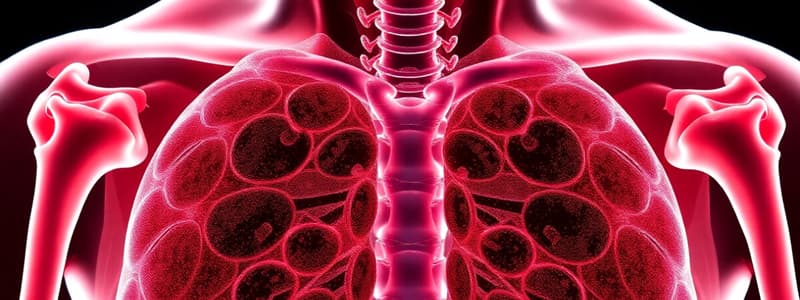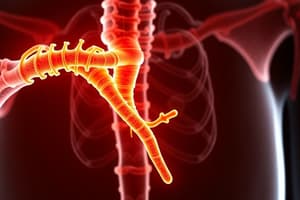Podcast
Questions and Answers
Which of the following cellular processes is NOT directly influenced by calcium?
Which of the following cellular processes is NOT directly influenced by calcium?
- Muscle contraction
- Neurotransmitter release
- Blood glucose regulation (correct)
- Cell adhesion
How does parathyroid hormone (PTH) influence calcium levels in the kidneys?
How does parathyroid hormone (PTH) influence calcium levels in the kidneys?
- By inhibiting the activation of calcitriol
- By increasing calcium reabsorption in the proximal convoluted tubule (PCT) and distal convoluted tubule (DCT) (correct)
- By decreasing calcium reabsorption in the proximal convoluted tubule (PCT) and distal convoluted tubule (DCT)
- By promoting calcium excretion
What is the primary mechanism by which calcitriol contributes to increased serum calcium levels?
What is the primary mechanism by which calcitriol contributes to increased serum calcium levels?
- Decreasing calcium reabsorption in the kidneys
- Enhancing calcium absorption in the small intestine (correct)
- Promoting calcium reabsorption from bone by decreasing osteoclast activity
- Inhibiting calcium absorption in the small intestine
If a patient has a malfunctioning thyroid gland that is not producing enough calcitonin, what is the likely consequence?
If a patient has a malfunctioning thyroid gland that is not producing enough calcitonin, what is the likely consequence?
Which of the following conditions is NOT a direct cause of hypocalcemia?
Which of the following conditions is NOT a direct cause of hypocalcemia?
How does increased serum pH contribute to hypocalcemia?
How does increased serum pH contribute to hypocalcemia?
What is a likely effect of hypocalcemia on nerve and muscle function?
What is a likely effect of hypocalcemia on nerve and muscle function?
Which of the following is NOT a direct cause of Hypercalcemia?
Which of the following is NOT a direct cause of Hypercalcemia?
What effect does hypercalcemia likely have on cardiac muscle contractions?
What effect does hypercalcemia likely have on cardiac muscle contractions?
How does calcitonin reduce serum calcium levels through its action on bone tissue?
How does calcitonin reduce serum calcium levels through its action on bone tissue?
In response to low serum calcium, which of the following is an immediate action taken by the parathyroid hormone (PTH)?
In response to low serum calcium, which of the following is an immediate action taken by the parathyroid hormone (PTH)?
Which cells in the thyroid gland are responsible for sensing high serum calcium levels and subsequently releasing calcitonin?
Which cells in the thyroid gland are responsible for sensing high serum calcium levels and subsequently releasing calcitonin?
How does the body respond to high serum calcium levels in terms of calcitriol production and its effect on osteoclasts?
How does the body respond to high serum calcium levels in terms of calcitriol production and its effect on osteoclasts?
What is the effect of hypercalcemia on the production and function of antidiuretic hormone (ADH)?
What is the effect of hypercalcemia on the production and function of antidiuretic hormone (ADH)?
Which of the following enzymes does calcium NOT play a crucial role in regulating activity?
Which of the following enzymes does calcium NOT play a crucial role in regulating activity?
In the kidneys, how does calcitonin influence calcium reabsorption and what is the resulting outcome?
In the kidneys, how does calcitonin influence calcium reabsorption and what is the resulting outcome?
A patient presents with spontaneous muscle spasms and tetany. Assuming this is due to a calcium imbalance, which of the following is the most likely underlying cause?
A patient presents with spontaneous muscle spasms and tetany. Assuming this is due to a calcium imbalance, which of the following is the most likely underlying cause?
How does PTH indirectly affect calcium absorption in the small intestine, and why is this indirect action important?
How does PTH indirectly affect calcium absorption in the small intestine, and why is this indirect action important?
A patient with chronic kidney disease has difficulty maintaining normal calcium levels. Which of the following mechanisms is most likely impaired in this patient?
A patient with chronic kidney disease has difficulty maintaining normal calcium levels. Which of the following mechanisms is most likely impaired in this patient?
Which of the following conditions would most likely be treated with calcitonin?
Which of the following conditions would most likely be treated with calcitonin?
Flashcards
Importance of Calcium
Importance of Calcium
Essential for bone structure, muscle contraction, neurotransmitter release, intracellular communication, metabolism, signaling, enzyme activity, endocytosis, exocytosis, cell adhesion, blood clotting, cell replication, fertilization, motility, and capillary permeability.
Sensor for Low Calcium
Sensor for Low Calcium
The parathyroid gland detects low serum calcium levels and releases parathyroid hormone (PTH).
Kidney and PTH effect on Calcium
Kidney and PTH effect on Calcium
PTH increases calcium reabsorption in the kidneys, activates calcitriol, and increases calcium release from bone.
Calcitriol's Role
Calcitriol's Role
Signup and view all the flashcards
Sensor for High Calcium
Sensor for High Calcium
Signup and view all the flashcards
Calcitonin's Effects
Calcitonin's Effects
Signup and view all the flashcards
Causes of Hypocalcemia
Causes of Hypocalcemia
Signup and view all the flashcards
Effects of Hypocalcemia
Effects of Hypocalcemia
Signup and view all the flashcards
Causes of Hypercalcemia
Causes of Hypercalcemia
Signup and view all the flashcards
Effects of Hypercalcemia
Effects of Hypercalcemia
Signup and view all the flashcards
Study Notes
- Calcium is vital for bone structure, muscle contraction, neurotransmitter release, intracellular communication, metabolism, signaling, and enzyme activity.
- It also plays a key role in endocytosis, exocytosis, cell adhesion, blood clotting, cell replication, fertilization, motility, and capillary permeability.
Response to Low Serum Calcium (Hypocalcemia)
- When serum calcium levels are low, the parathyroid gland acts as the sensor.
- The parathyroid gland releases parathyroid hormone (PTH) into the blood.
- In the kidneys, PTH increases calcium reabsorption in the proximal convoluted tubule (PCT) and distal convoluted tubule (DCT).
- PTH activates calcitriol, which affects calcium availability. This occurs when calcitriol acts on the bone and small intestines.
- In bone, PTH increases calcium reabsorption by increasing osteoclast activity, which moves calcium from bone to blood.
- Calcitriol increases osteoclast maturation, increasing their numbers.
- In the small intestine, calcitriol increases calcium absorption from the diet.
Response to High Serum Calcium (Hypercalcemia)
- When serum calcium is high, perifollicular cells of the thyroid gland act as the sensor.
- The thyroid gland releases calcitonin into the blood.
- The kidneys stop inducing calcium reabsorption, leading to calcium excretion in the urine.
- In bone, calcitonin decreases osteoclast activity, increasing bone calcification due to osteoblast activity.
- Less calcitriol production results in fewer osteoclasts.
- No calcitriol means less calcium absorption in the small intestine from food.
Hypocalcemia
- Hypocalcemia can be caused by hypothyroidism, malabsorption syndrome, deficient serum albumin, or increased serum pH.
- The effects of hypocalcemia include increased permeability and excitability of nerve membranes.
- Hypocalcemia can also cause spontaneous stimulation of skeletal muscle and weak heart contractions (repolarization is not complete).
Hypercalcemia
- Hypercalcemia can be caused by uncontrolled calcium release from bones, bone demineralization from immobility, or increased calcium intake.
- The effects of hypercalcemia include depressed neuromuscular activity and interference with ADH production.
- Hypercalcemia may also increase the strength of cardiac muscle contractions.
Studying That Suits You
Use AI to generate personalized quizzes and flashcards to suit your learning preferences.




